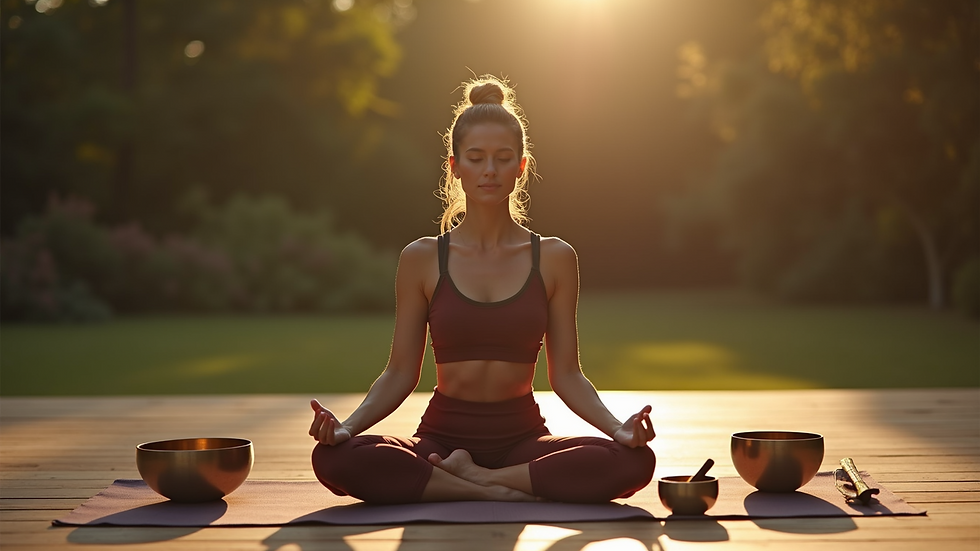Unlock Your Inner Peace with Yoga and Sound Therapy
- Rajkumar u
- 3 days ago
- 3 min read
In a world filled with constant noise and stress, finding moments of calm can feel like a challenge. Many people seek ways to restore balance and peace in their lives. Yoga and sound therapy offer powerful tools to help you reconnect with yourself and unlock a deep sense of inner peace. This post explores how combining these two practices can transform your mental and physical well-being.

How Yoga Creates a Foundation for Inner Peace
Yoga is more than just physical exercise. It is a practice that unites the body, mind, and breath. Through mindful movement and focused breathing, yoga helps reduce tension and cultivates awareness.
Breath control: Yoga emphasizes deep, controlled breathing, which activates the parasympathetic nervous system. This response lowers heart rate and calms the mind.
Mindful movement: Holding poses with attention encourages presence and reduces mental chatter.
Physical release: Stretching and strengthening muscles release stored tension and improve circulation.
For example, practicing gentle poses like Child’s Pose or Legs-Up-The-Wall can immediately soothe the nervous system. Over time, regular yoga sessions build resilience against stress and promote emotional balance.
The Role of Sound Therapy in Enhancing Relaxation
Sound therapy uses vibrations and tones to influence brainwaves and encourage relaxation. Instruments such as singing bowls, tuning forks, and gongs produce sounds that can shift your mental state.
Vibrational healing: Sound waves stimulate the body’s cells and can reduce physical and emotional blockages.
Brainwave entrainment: Certain frequencies encourage alpha and theta brainwaves, associated with calm and meditative states.
Emotional release: Listening to soothing sounds helps release anxiety and promotes a sense of safety.
For instance, a 30-minute session with Tibetan singing bowls can lower cortisol levels, the hormone linked to stress. Many people report feeling lighter and more centered after sound therapy.
Combining Yoga and Sound Therapy for Deeper Peace
When yoga and sound therapy are combined, their effects amplify. The physical and mental preparation from yoga makes the body more receptive to sound vibrations. Meanwhile, sound therapy deepens the meditative state reached through yoga.
Here’s how to integrate both practices:
Start with gentle yoga: Begin your session with slow, mindful poses to ground yourself.
Introduce sound elements: Use singing bowls or soft chimes during relaxation poses.
End with guided sound meditation: Lie down and focus on the sounds to deepen your calm.
This combination can be especially helpful for those who struggle with restless minds during meditation. The sound acts as an anchor, while yoga prepares the body to relax fully.
Practical Tips for Starting Your Practice at Home
You don’t need special equipment or a large space to begin. Here are some simple steps:
Create a quiet corner: Find a peaceful spot where you won’t be disturbed.
Use online resources: Many free yoga and sound therapy videos are available for beginners.
Set a regular schedule: Even 15 minutes daily can make a difference.
Choose comfortable clothing: Wear loose, breathable clothes to move freely.
Experiment with sounds: Try different instruments or apps to find what resonates with you.
For example, you might start your day with a short yoga flow followed by five minutes of listening to a singing bowl recording. Over time, you can extend the duration or explore new poses and sounds.
Benefits Backed by Research
Studies support the positive effects of yoga and sound therapy on mental health:
Yoga reduces symptoms of anxiety and depression by regulating stress hormones.
Sound therapy has been shown to improve sleep quality and reduce pain perception.
Combining both practices enhances mindfulness and emotional regulation.
One study found that participants who practiced yoga followed by sound meditation reported lower stress levels and improved mood compared to those who only did yoga.
Overcoming Common Challenges
Starting a new wellness routine can feel overwhelming. Here are ways to stay motivated:
Set realistic goals: Begin with short sessions and gradually increase.
Be patient: Inner peace develops over time, not instantly.
Seek community: Join local classes or online groups for support.
Listen to your body: Modify poses and sounds to suit your comfort.
Remember, the goal is progress, not perfection. Each session is a step toward greater calm.
Bringing Inner Peace into Daily Life
The benefits of yoga and sound therapy extend beyond your practice time. You can carry this calm into everyday moments by:
Taking mindful breaths during stressful situations.
Using sound apps for quick relaxation breaks.
Practicing gentle stretches at your desk.
Creating a calming bedtime routine with sound meditation.
These small habits help maintain balance and reduce the impact of daily stressors.
Unlocking your inner peace is a journey that blends movement, breath, and sound. Yoga prepares your body and mind, while sound therapy deepens your relaxation. Together, they offer a powerful way to restore calm and clarity. Start with small steps today and discover how these practices can transform your life.


Comments